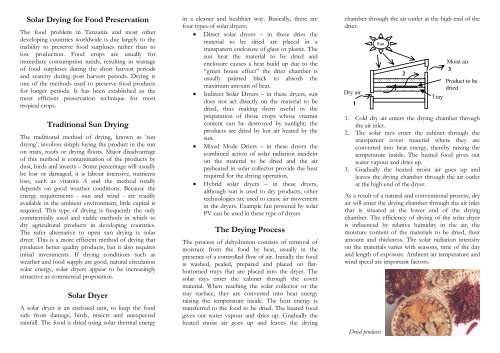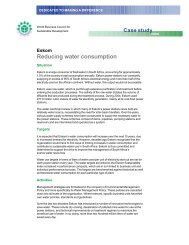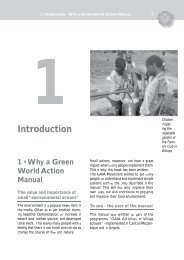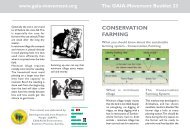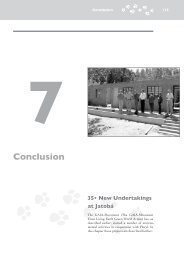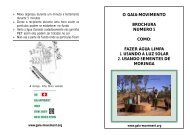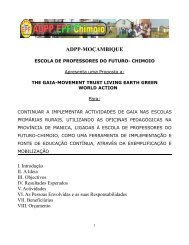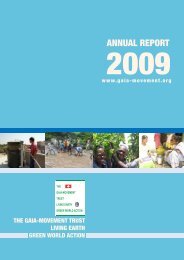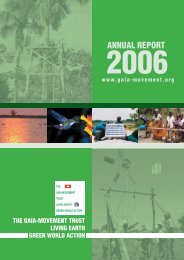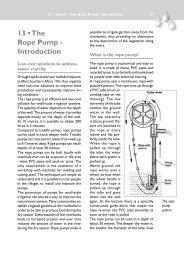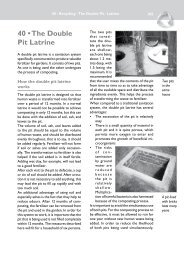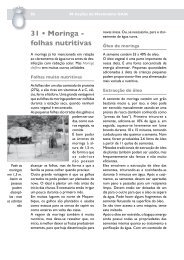Solar Drying for Food Preservation - The Gaia-Movement
Solar Drying for Food Preservation - The Gaia-Movement
Solar Drying for Food Preservation - The Gaia-Movement
Create successful ePaper yourself
Turn your PDF publications into a flip-book with our unique Google optimized e-Paper software.
<strong>Solar</strong> <strong>Drying</strong> <strong>for</strong> <strong>Food</strong> <strong>Preservation</strong><br />
<strong>The</strong> food problem in Tanzania and most other<br />
developing countries worldwide is due largely to the<br />
inability to preserve food surpluses rather than to<br />
low production. <strong>Food</strong> crops are usually <strong>for</strong><br />
immediate consumption needs, resulting in wastage<br />
of food surpluses during the short harvest periods<br />
and scarcity during post harvest periods. <strong>Drying</strong> is<br />
one of the methods used to preserve food products<br />
<strong>for</strong> longer periods. It has been established as the<br />
most efficient preservation technique <strong>for</strong> most<br />
tropical crops.<br />
Traditional Sun <strong>Drying</strong><br />
<strong>The</strong> traditional method of drying, known as ‘sun<br />
drying’, involves simply laying the product in the sun<br />
on mats, roofs or drying floors. Major disadvantage<br />
of this method is contamination of the products by<br />
dust, birds and insects – Some percentage will usually<br />
be lost or damaged, it is labour intensive, nutrients<br />
loss, such as vitamin A and the method totally<br />
depends on good weather conditions. Because the<br />
energy requirements - sun and wind - are readily<br />
available in the ambient environment, little capital is<br />
required. This type of drying is frequently the only<br />
commercially used and viable methods in which to<br />
dry agricultural products in developing countries.<br />
<strong>The</strong> safer alternative to open sun drying is solar<br />
dryer. This is a more efficient method of drying that<br />
produces better quality products, but it also requires<br />
initial investments. If drying conditions such as<br />
weather and food supply are good, natural circulation<br />
solar energy, solar dryers appear to be increasingly<br />
attractive as commercial proposition.<br />
<strong>Solar</strong> Dryer<br />
A solar dryer is an enclosed unit, to keep the food<br />
safe from damage, birds, insects and unexpected<br />
rainfall. <strong>The</strong> food is dried using solar thermal energy<br />
in a cleaner and healthier way. Basically, there are<br />
four types of solar dryers;<br />
• Direct solar dryers – in these dries the<br />
material to be dried are placed in a<br />
transparent enclosure of glass or plastic. <strong>The</strong><br />
sun heat the material to be dried and<br />
enclosure causes a heat build up due to the<br />
“green house effect” the drier chamber is<br />
usually painted black to absorb the<br />
maximum amount of heat.<br />
• Indirect <strong>Solar</strong> Dryers – in these dryers, sun<br />
does not act directly on the material to be<br />
dried, thus making them useful in the<br />
preparation of those crops whose vitamin<br />
content can be destroyed by sunlight; the<br />
products are dried by hot air heated by the<br />
sun.<br />
• Mixed Mode Driers – in these dryers the<br />
combined action of solar radiation incident<br />
on the material to be dried and the air<br />
preheated in solar collector provide the heat<br />
required <strong>for</strong> the drying operation.<br />
• Hybrid solar dryers – in these dryers,<br />
although sun is used to dry products, other<br />
technologies are used to cause air movement<br />
in the dryers. Example fan powered by solar<br />
PV can be used in these type of dryers<br />
<strong>The</strong> <strong>Drying</strong> Process<br />
<strong>The</strong> process of dehydration consists of removal of<br />
moisture from the food by heat, usually in the<br />
presence of a controlled flow of air. Initially the food<br />
is washed, pealed, prepared and placed on flatbottomed<br />
trays that are placed into the dryer. <strong>The</strong><br />
solar rays enter the cabinet through the cover<br />
material. When reaching the solar collector or the<br />
tray surface, they are converted into heat energy<br />
raising the temperature inside. <strong>The</strong> heat energy is<br />
transferred to the food to be dried. <strong>The</strong> heated food<br />
gives out water vapour and dries up. Gradually the<br />
heated moist air goes up and leaves the drying<br />
chamber through the air outlet at the high end of the<br />
drier.<br />
Dry air<br />
1<br />
Sun<br />
2<br />
Tray<br />
Moist air<br />
3<br />
Product to be<br />
dried<br />
1. Cold dry air enters the drying chamber through<br />
the air inlet.<br />
2. <strong>The</strong> solar rays enter the cabinet through the<br />
transparent cover material where they are<br />
converted into heat energy, thereby raising the<br />
temperature inside. <strong>The</strong> heated food gives out<br />
water vapour and dries up.<br />
3. Gradually the heated moist air goes up and<br />
leaves the drying chamber through the air outlet<br />
at the high end of the dryer.<br />
As a result of a natural and conventional process, dry<br />
air will enter the drying chamber through the air inlet<br />
that is situated at the lower end of the drying<br />
chamber. <strong>The</strong> efficiency of drying of the solar dryer<br />
is influenced by relative humidity in the air, the<br />
moisture content of the materials to be dried, their<br />
amount and thickness. <strong>The</strong> solar radiation intensity<br />
on the materials varies with seasons, time of the day<br />
and length of exposure. Ambient air temperature and<br />
wind speed are important factors.<br />
Dried products
<strong>Solar</strong> <strong>Drying</strong> <strong>for</strong> Income Generation<br />
Experience in similar solar dryer projects <strong>for</strong> fruits<br />
and vegetables prove that solar drying can be<br />
attractive as a method <strong>for</strong> food preservation and also<br />
as a commercial proposition. <strong>Drying</strong> conditions in<br />
Tanzania are very favourable and initiation of a solar<br />
dryer project can in more than one way improve the<br />
standard of life in rural areas. First of all, it will<br />
provide employment <strong>for</strong> people particularly women<br />
– in rural areas by creating sustainable income<br />
generating opportunities at low cost. <strong>The</strong> solar dried<br />
fruits and vegetables can be sold as ‘natural’<br />
(untreated) products, <strong>for</strong> which is increasing demand<br />
and market price advantage – also as ‘fair-traded<br />
products’ on international markets. But also locally<br />
there is a market <strong>for</strong> dried products, if promoted<br />
sufficiently<br />
<strong>Solar</strong> <strong>Drying</strong> Services<br />
Initiating a project in the field of solar drying,<br />
TaTEDO has planned activities in the following<br />
areas<br />
• Training in dryer operation including food<br />
processing, business management and<br />
market development<br />
• Promotion, demonstration and<br />
dissemination of solar drying technology to<br />
potential producers.<br />
• Supporting of commercial solar drying<br />
enterprises by provision of in<strong>for</strong>mation on<br />
solar drying technology, trouble shooting<br />
and assistance in market development<br />
activities.<br />
• Carrying out studies regarding solar drying<br />
technology and market opportunities.<br />
In solar energy, TaTEDO also provides services in<br />
the field of solar PV and solar cookers. In addition,<br />
TaTEDO offers technical services in Bio-energy<br />
technologies, wind energy technologies, small<br />
hydropower and tree growing.<br />
About TaTEDO<br />
TaTEDO is a coalition of individuals,<br />
professionals, artisans, farmers, Community<br />
Based Organisations (CBOs) and micro<br />
enterprises involved in the development and<br />
promotion of renewable energy systems <strong>for</strong><br />
enhancing sustainable environment and socioeconomic<br />
development of communities. <strong>The</strong><br />
organisation was registered in 1990 as a national<br />
non-governmental, non-profit energy and<br />
environment organisation.<br />
Renewable energies are mostly indigenous and<br />
traditional energy source, which are regenerated<br />
during the annual solar cycle. Technologies <strong>for</strong><br />
their conversion and utilization are environment<br />
friendly. <strong>The</strong> long-term objective of TaTEDO is<br />
of offer a wide range of services in renewable<br />
energy technologies and practices<br />
For detailed in<strong>for</strong>mation contact:<br />
Executive Director<br />
TaTEDO<br />
P.O. Box 32794<br />
Dar es Salaam<br />
Tanzania<br />
Off Shekilango<br />
Road, near Institute<br />
of Social Work -<br />
Kijitonyama<br />
Phone numbers:<br />
+255 222 700 438<br />
+255 222 700 771<br />
Fax:<br />
+255 222 774 400<br />
Email:energy@tatedo.org<br />
Website:www.tatedo.org<br />
TaTEDO contributes to poverty<br />
alleviation ef<strong>for</strong>ts through promotion of<br />
improved energy services<br />
Tanzania Traditional Energy Development<br />
and Environment Organisation<br />
<strong>Solar</strong> <strong>Drying</strong><br />
Technology <strong>for</strong> Poverty<br />
Alleviation, Environment<br />
Conservation and<br />
Sustainable Rural<br />
Development


